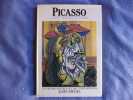Josep Palau I Fabre
Picasso
Albin Michel 1981 collection les grands maitres de l'art contemporain. in 4. 1981. relié avec jaquette.
Reference : 2147490315
Très bon état
Bookseller's contact details
Fraguas Margaux
Mme Margaux Fraguas
23 rue Armand Izarn
66100 Perpignan
France
06 12 21 42 25
Payment mode

Sale conditions
Colissimo France : 7 euros International : Livre et brochure 6 euros
5 book(s) with the same title
Anne Baldassari Francis Bacon Pablo Picasso
Reference : 500072644
(2005)
ISBN : 9782080114143
Bacon Picasso - la vie des images
2005 237 pages 2005. 237 pages.
Très bon état - légères marques de lecture et/ou de stockage mais du reste en très bon état- expédié soigneusement depuis la France
Anne Baldassari Francis Bacon Pablo Picasso
Reference : 500058426
(2005)
ISBN : 9782080114143
Anne Baldassari Francis Bacon Pablo Picasso
Reference : 500047416
(2005)
ISBN : 9782080114143
Bacon Picasso - la vie des images (Très bon état)
2005 237 pages 2005. 237 pages.
Très bon état - légères marques de lecture et/ou de stockage mais du reste en très bon état- expédié soigneusement depuis la France
Anne Baldassari Francis Bacon Pablo Picasso
Reference : 500047419
(2005)
ISBN : 9782080114143
Reference : 300029956
 Write to the booksellers
Write to the booksellers

